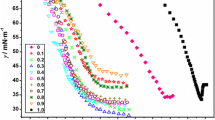Abstract
The critical micelle concentration (CMC) of a set of 30 alkyltrimethylammonium [RN+(R′)3X−] and alkylpyridinium salts [RN+ΦX−] was related to topological, electronic, and molecular structure parameters using a stepwise regression method. Among different models obtained, two equations were selected as the best and their specifications are given. The statistics for these models together with the crossvalidation results indicate the capability of both models to predict the CMC of cationic surfactants. The results obtained for alkyltrimethylammonium salts indicate that geometric characteristics such as volume of the tail of the molecule, maximum distance between the atoms, and surface area play a major role in micelle formation. However, the simultaneous modeling of the CMC of both alkyltrimethylammonium and alkylpyridinium salts indicates that the topological descriptors of the Balaban and Randic indices and also the electronic parameter of total energy of the molecules are important.
Similar content being viewed by others
Abbreviations
- BAL:
-
Balaban index
- CMC:
-
critical micelle concentration
- E:
-
total energy
- HEAT−1 :
-
reciprocal of heat of formation
- MAXDIS:
-
maximum distance between the atoms of the molecule
- MEKC:
-
micellar electrokinetic chromatography
- MLC:
-
micellar liquid chromatography
- MLR:
-
multiple linear regression
- R :
-
multiple correlation coefficient
- RA:
-
Randic index
- S:
-
surface area
- SE:
-
standard error
- VT:
-
volume of the tail of the molecule
References
Myers, D., Surfactant Science and Technology, 2nd edn., VCH Publishers, 1992, p. 61.
Porter, M.R., Handbook of Surfactants, 2nd edn., Chapman & Hall, New York, 1994, p. 116.
Brooks, S.H., A. Berthod, B.A. Krisch, and J.G. Dorsey, Flow Injection System for Determination of Critical Micelle Concentrations of Ionic and Nonionic Surfactants, Anal. Chim. Acta 209:111 (1988).
Rosen, M.J., Surfactants and Interfacial Phenomena, John Wiley & Sons, New York, 1989, p. 106.
Yaroshenko, N.A., and Zh.M. Aryamova, Accounting for Surface Tension in the Determination of Critical Micelle Concentration for Aqueous Solutions of Ionic Surfactants, Ukr. Khim. Zh. 51:466 (1985).
Jalali-Heravi, M., and E. Konouz, Prediction of Critical Micelle Concentration of Some Anionic Surfactants Using Multiple Regression Techniques: A Quantitative Structure-Activity Relationship Study, J. Surfact. Deterg. 3:1 (2000).
Nakamura, H., A. Sano, and K. Matsuura, Determination of Critical Micelle Concentration of Anionic Surfactants by Capillary Electrophoresis Using 2-Naphthalenemethanol as a Marker for Micelle Formation, Anal. Sci. 14:379 (1998).
Kawakatsu, T., K. Kawasaki, and F. Hirofumi, Theories and Computer Simulations of Self-Assembly Surfactant Solutions, J. Phys. Condens. Matter 6:6385 (1994).
Karaborni, S., K. Esselink, P.A.J. Hilbers, and B. Smit, Simulating Surfactant Self-Assembly, J. Phys. Condens. Matter 6 (Suppl. 23A):A351 (1994).
Zoller, N.J., A. Shiloach, and D. Blankschten, Predicting Surfactant Solution Behaviour, CHEMTECH 26:24 (1996).
Jalali-Heravi, M., and E. Konouz, Use of Quantitative Structure-Activity Relationships in Prediction of CMC of Nonionic Surfactants, Quant. Struct. Act. Relat. 19:135 (2000).
SPSS/PC, The Statistical Package for IBM PC, Quiad Software, Ontario, Canada, 1986.
MOPAC, Version 6, U.S. Air Force Academy, Colorado Springs, 1990.
Hyperchem, Release 3 for Windows, Molecular Modeling System, Hypercube, Inc. and Autodesk, Ringoes, NJ, 1993.
Van Os, N.M., J.R. Haak, and L.A.M. Rupert, Physico-chemical Properties of Selected Anionic, Cationic and Nonionic Surfactants, Elsevier Science, New York, 1993, p. 9.
Wiener, H., Structural Determination of Paraffin Boiling Points, J. Am. Chem. Soc. 69:17 (1947).
Randic, M., Rearrangement of the Connectivity Matrix of a Gaph Reply to Comments, J. Chem. Phys. 62:309 (1973).
Balaban, A.T., Highly Discriminating Distance-Based Topological Index, Chem. Phys. Lett. 89:399 (1982).
Stouch, T.R., and P.C. Jurs, A Simple Method for the Representation, Qualification and Comparision of the Volumes and Shapes of Chemical Compounds, J. Chem. Inf. Comput. Sci. 26:4 (1986).
Dewar, M.J.S., E.G. Zoebish, J.J.P. Stewart, and E.F. Healy, AM1: A New General Purpose Quantum Mechanical Molecular Model, J. Chem. Soc. 107:3902 (1985).
George, D., and P. Mallery, SPSS/PC+Step by Step, A Simple Guide and Reference, Wadsworth, Belmont, CA, 1995, p. 168.
Cramer, R.D., D.E. Patterson, and J.D. Bunce, Effect of Shape on Binding of Steroids to Carrier Proteins, J. Am. Chem. Soc. 110:5959 (1988).
Mihalic, Z., and N. Trinajstic, A Graph-Theoretical Approach to Structure-Property Relationships, J. Chem. Educ. 69:701 (1992).
Stache, H.W., Anionic Surfactants, Organic Chemistry, Vol. 56, Marcel Dekker, New York, 1996, p. 243.
Klvenes, H.B., Structure and Aggregation in Dilute Solutions of Surface Active Agents, J. Am. Oil Chem. Soc. 30:78 (1953).
Wright, K., and H.V. Tartar, Solubilities, Micelle Formation and Hydrates of the Sodium Salts of the Higher Alkylsulfonates, J. Am. Chem. Soc. 61:539 (1939).
Kier, L.B., and L.H. Hall, Molecular Connectivity in Chemistry and Drug Research, Academic Press, New York, 1976.
Author information
Authors and Affiliations
Corresponding author
About this article
Cite this article
Jalali-Heravi, M., Konouz, E. Multiple linear regression modeling of the critical micelle concentration of alkyltrimethylammonium and alkylpyridinium salts. J Surfact Deterg 6, 25–30 (2003). https://doi.org/10.1007/s11743-003-0244-7
Received:
Accepted:
Issue Date:
DOI: https://doi.org/10.1007/s11743-003-0244-7




